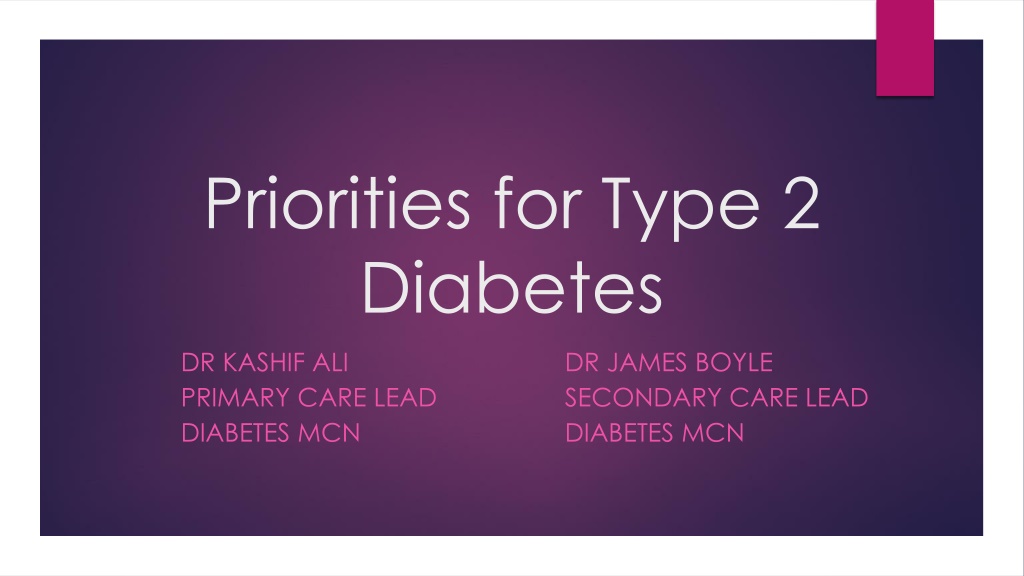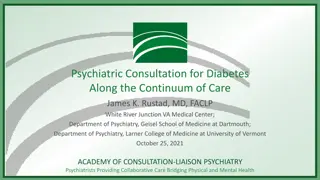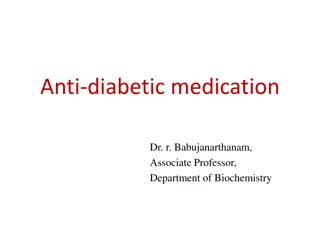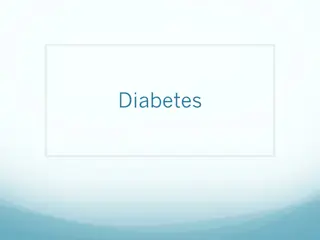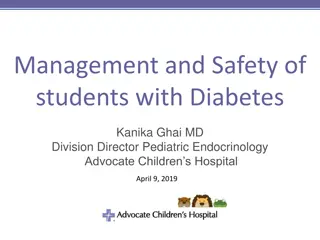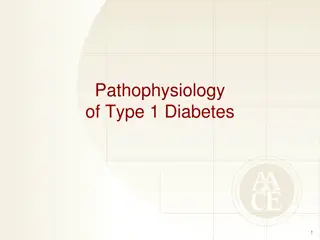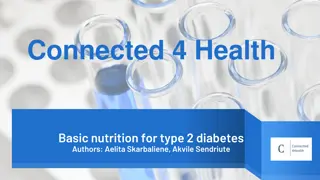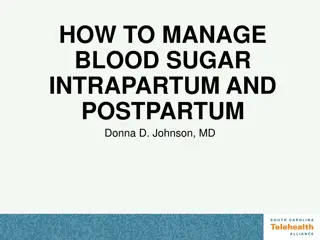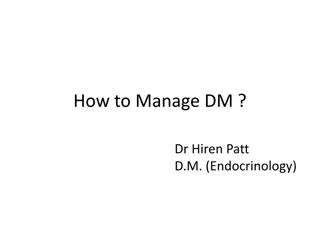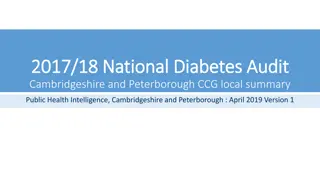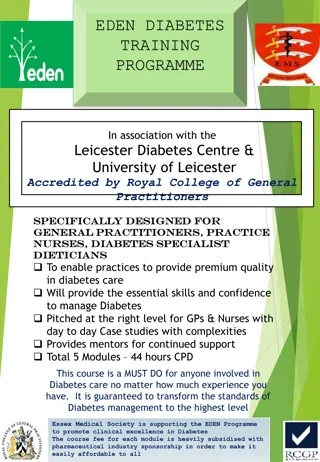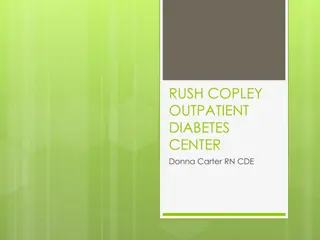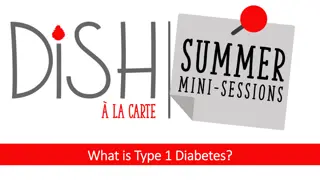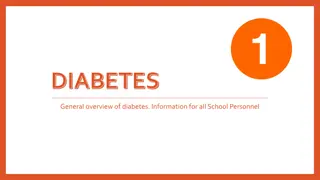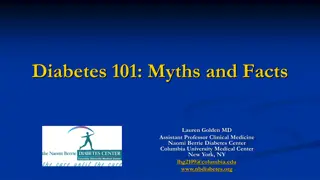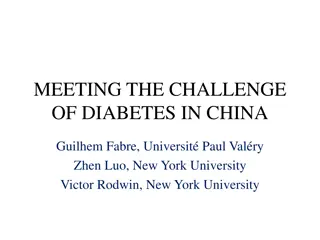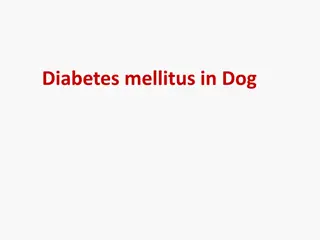Priorities and Quality Measures for Type 2 Diabetes Care in NHS GGC
Dr. Kashif Ali leads primary care for Type 2 diabetes, while Dr. James Boyle oversees secondary care in NHS GGC. The data from December 2018 shows the number of Type 2 diabetes patients, their care processes, HbA1c levels, and BMI status. The Diabetes Quality Improvement and Outcome Measures aim to enhance diabetes care quality in Scotland. The provided charts illustrate the percentages of patients receiving all care processes, HbA1c levels, and regional data on care quality. Plans for 2019/20 include pathway consultation, guidelines development, and enhanced diabetes management. The importance of collaborative management plans, non-pharmacological approaches, and regular medication reviews is emphasized for quality prescribing in diabetes care.
Download Presentation

Please find below an Image/Link to download the presentation.
The content on the website is provided AS IS for your information and personal use only. It may not be sold, licensed, or shared on other websites without obtaining consent from the author. Download presentation by click this link. If you encounter any issues during the download, it is possible that the publisher has removed the file from their server.
E N D
Presentation Transcript
Priorities for Type 2 Diabetes DR KASHIF ALI PRIMARY CARE LEAD DIABETES MCN DR JAMES BOYLE SECONDARY CARE LEAD DIABETES MCN
Type 2 Diabetes in NHS GGC December 2018: 57,643 patients with Type 2 diabetes Patients receiving ALL 9 Processes of Care : 41.4% Patients with HbA1c < 58mmol/l: 59.1% Patients with BMI >/= 25kg/m2: 86%
The Diabetes Quality Improvement and Outcome Measures 12 Diabetes Quality improvement and outcome measures were agreed to provide information about quality of diabetes care provided in Scotland. Data available Quarterly Shared with Secondary Care Centres and HSCPs/GP clusters Purpose is to support improvements and sharing of best practice Unfiltered Data
Q4 2018 - Type 2 Patients Receiving ALL 9 Processes of Care Q4 2018 - Type 2 Patients Receiving ALL 9 Processes of Care 70% 61.9% 60% 60.0% 58.6% 60% 50% 49.2% 47.7% 50% 46.8% 44.0% 44.0% 43.9% 43.2% 43.1% 43% 43% 41% 42.6% 40% 41.3% 41% 40.4% 40% 40.2% 39.2% 39.0% 38.8% 38.8% 40% Q1/18 37.1% 37.0% 36.1% 34.7% 33.1% Q2/18 Q3/18 30% Q4/18 20% 10% 0% East Dun East Ren Glasgow NE Glasgow NW Glasgow South Inverclyde Renfrewshire West Dun
Q4 2018 Type 2 HbA1c Recorded by GG&C HSCP Q4 2018 Type 2 HbA1c Recorded by GG&C HSCP 70% 58.2% 60% 55.8% 55.2% 55.1% 54.5% 52.9% 50.5% 49.8% 50% % HbA1C > 58 % HbA1C 58 to 75 40% % HbA1C > 75 30% 24.3% 23.6% 23.5% 23.5% 23.4% 23.3% 22.1% 21.9% % HbA1C > Not Recorded 20% 15.8% 14.2% 13.1% 13.0% 12.8% 12.5% 12.0% 11.9% 11.1% 10.2% 10.2% 10.1% 9.8% 8.7% 8.3% 8.2% 10% 0% East Dun East Ren Glasgow NE Glasgow NW Glasgow South Inverclyde Renfrewshire West Dun
MCN Type 2 Priorities for 2019/20 Consultation of Type 2 pathway and formalising support for primary care from secondary care. New GG&C Type 2 Guidelines and Educational events New GMS Contract and improving the management of Diabetes Prevention of Type 2 Diabetes Type 2 Education
Quality Prescribing in Diabetes: National Guidance Develop a Clear Management Plan collaboratively with patients + should focus on what matters to you Pursue Non-Pharmacological Approaches encourage self-management e.g My Diabetes My Way Follow a clinically appropriate approach to initiation of medication discussing risks v benefits Review effectiveness, tolerability and adherence on a regular basis and in line with Polypharmacy guidance
Image result for the modern outpatient Image result for house of care scotland Image result for practising realistic medicine
Proposed Type 2 Pathway Email, Sci-gateway, Phone, Cluster phone, cDSN - patient and AHP education - GLP1 and basal insulin initiation -- liaison with primary care and lead consultant GP, Practice nurse, AHPs (including non medical prescribers) - review - care planning - stratification - intensification - education - CV risk management - complication Rx - liaison with cDSN and lead consultant Person with Type 2 Diabetes Email, Phone, Cluster, MDTs Consultant - above target after 3rd line - diagnostic dilemma (young, low BMI, pancreatic history) - AHP education - insulin intensification Email,Sci-Gateway, Phone, Cluster MDTs
Glasgow Weight Management Service BMI Condition Self-referral criteria 25 (22.5*) 30 (27.5*) Type 2 diabetes Type 1 diabetes Heart disease Stroke Health professional referral criteria 25 (22.5*) Impaired fasting glucose/ Impaired glucose tolerance/ High diabetes risk/ Previous GDM Type 2 diabetes Type 1 diabetes 25 (22.5*) 30 (27.5*) Bariatric surgery criteria (triaged by servce) Type 2 diabetes AND BMI 35-55 AND Age 18-55 AND Diabetes diagnosis <10 years 0141 211 3379 SELF-REFERRAL
B - INTENSIFICATION Emphasise the benefits of achieving and maintaining healthy BMI 1st line agent Arrange 3/12 HbA1c A+C -MONITORING Target HbA1c achieved (eg <53 mmol/mol) Arrange 6-12 monthly HbA1c If HbA1c above target, back into Rx algorithm 2nd line agent HbA1c 3/12 Treatment failure ie HbA1c drop <5.5mmol/mol, therefore stop RX and consider alternative from Rx line 3rd line agent HbA1c 3/12 4th line agent (typically need specialist support) GLP1 or basal insulin start (with cDSN support)* HbA1c 3/12 Insulin intensification beyond basal insulin ie introduction of prandial or premix regimes (case reviewed by specialist)*
FIRST LINE METFORMIN *SU *SGLT2i (if BMI>30 or CV disease) Weight loss CV (and BP) Low hypo risk Diuretics Thrush Ketosis Advantages Weight CV Low hypo risk GI Efficacy *Alternative to metformin if contraindicated or not tolerated Cautions/ side effects Hypos Weight gain Frailty BGM Contraindications CKD 4 CKD 3a (initiation) Frailty SECOND LINE Advantages SGLT2i Weight loss CV (and BP) Low hypo risk Diuretics Thrush Ketosis SU Efficacy DPP4i Weight Low hypo risk tolerated Efficacy CKD (adjustment) Pioglitazone Efficacy Low hypo risk Cautions/ side effects Hypos Weight gain Frailty BGM Oedema Central adiposity osteoporosis Contraindications CKD 3a (initiation) Frailty Pancreatic history CCF Bladder cancer (haematuria)
3rd agent from 2nd line As above THIRD LINE GLP1 RA O.D. insulin Advantages Efficacy Weight loss CV Low hypo risk GI Injections Efficacy Cautions/ side effects As above Hypos Weight gain BGM Injections Contraindications As above Pancreatic history CKD 4 (egfr <15 for some) FOURTH LINE Specialist input (cDSN and/or consultant) If >1 insulin injection required should be offered clinic review until stable
Obesity and /or CV disease If known CV disease, choose SGLT2i or GLP1 RA with proven CV benefit. *Alternative to metformin if contraindicated or not tolerated FIRST LINE METFORMIN *SU *SGLT2i (if BMI>30 or CV disease) SECOND LINE SGLT2i SU DPP4i Pioglitazone 3rd agent from 2nd line THIRD LINE GLP1 RA O.D. insulin
Elderly/Frail Relaxing glycaemic target may be appropriate eg HbA1c 65-75 mmol/mol, and concentrating on treating symptoms whilst minimising risks of potential side effects like hypoglycaemia. FIRST LINE METFORMIN *SU *SGLT2i (if BMI>30 and or CV disease) SECOND LINE DPP4i SGLT2i SU Pioglitazone 3rd agent from 2nd line THIRD LINE GLP1 RA O.D. insulin
CKD Drug/eGFR Metformin Sulphonylureas Empagliflozin >60 45-60 30-44 Reduce dose Caution No <30 No Caution No Reduce dose / don t initiate No Reduce dose / don t initiate Reduce dose if eGFR <50 Reduce dose if eGFR <50 Dapagliflozin Canagliflozin No No No No Sitagliptin Reduce dose Reduce dose further Reduce dose further Alogliptin Reduce dose Linagliptin Pioglitazone Liraglutide Dulaglutide Exenatide Exenatide MR Lixisenatide Stop <15 Stop <15 No No No Caution if eGFR <50 Stop <50 Caution if eGFR <50 Caution No Caution
Case 1 46 year old male with new diagnosis of T2DM No osmotic symptoms No macrovascular disease No retinopathy Non-Smoker, BMI 32 HbA1c 68, BP 158/86, TC 4.2 eGFR >60, Urine ACR 1.6 Low risk feet Ramipril 5mg od, Atorvastatin 10mg od. Anything else you would like to know? What would you do next to manage T2D?
Case 1 46 year old male with new diagnosis of T2DM No osmotic symptoms No macrovascular disease No retinopathy Non-Smoker, BMI 32 HbA1c 68, BP 158/86, TC 4.2 eGFR >60, Urine ACR 1.6 Low risk feet Ramipril 5mg od, Atorvastatin 10mg od. Consider: GWMP, Metformin, review Ramipril
Case 2 52 year old female with 5 year history of T2DM Osmotic symptoms History of MI No history of microvascular disease Smoker, BMI 34 HbA1c 71 (May) to 68 (Nov) after addition of DPP4i BP 132/75, TC 4.2, eGFR >60, Urine ACR 2.5 Low risk feet Metformin 1g bd, Alogliptin 25mg, Aspirin 75mg od, Ramipril 5mg od, Atorvastatin 40mg od. Anything else you would like to know? What would you do next to manage T2D?
Case 2 52 year old female with 5 year history of T2DM Osmotic symptoms History of MI No history of microvascular disease Smoker, BMI 34 HbA1c 71 (May) to 68 (Nov) after addition of DPP4i BP 132/75, TC 4.2, eGFR >60, Urine ACR 2.5 Low risk feet Metformin 1g bd, Alogliptin 25mg, Aspirin 75mg od, Ramipril 5mg od, Atorvastatin 40mg od. Consider: GWMP, stop DPP4i, SGLTi (proven benefit), Smoking cessation services.
Case 3 64 year old male with 20 year history of T2DM Osmotic symptoms Peripheral neuropathy, Retinopathy History of MI, CVA Ex-smoker, BMI 40 HbA1c 75 (Aug), 73 (Nov), BP 112/67, TC 3.2, eGFR 40, Urine ACR 2.3 Active foot ulceration. Metformin 1g bd, Empagliflozin 25mg od, Aspirin 75mg od, Ramipril 10mg od, Amlodipine 10mg od, Atorvastatin 80mg od. Anything else you would like to know? What would you do next to manage T2D?
Case 3 64 year old male with 20 year history of T2DM Osmotic symptoms Peripheral neuropathy, Retinopathy History of MI, CVA Ex-smoker, BMI 40 HbA1c 75 (Aug), 73 (Nov) BP 112/67, TC 3.2, eGFR 40, Urine ACR 2.3 Active foot ulceration. Metformin 1g bd, Empagliflozin 25mg od, Aspirin 75mg od, Ramipril 10mg od, Amlodipine 10mg od, Atorvastatin 80mg od. Consider: GWMP, Stop SGLTi, Add GLP (proven benefit)
Case 4 86 year old female with 10 year history of T2DM No osmotic symptoms Peripheral neuropathy No retinopathy No macrovascular disease Non-Smoker, BMI 27 HbA1c 70 (Jan), 47 (Nov) after addition of SU BP 140/80, TC 3.9 eGFR 47, Urine ACR 2.5 Moderate risk feet Metformin 1g bd, Gliclazide 80mg bd. Anything else you would like to know? What would you do next to manage T2D?
Case 4 86 year old female with 10 year history of T2DM No osmotic symptoms Peripheral neuropathy No retinopathy No macrovascular disease Non-Smoker, BMI 27 HbA1c 70 (Jan), 47 (Nov) after addition of SU BP 140/80, TC 3.9 eGFR 47, Urine ACR 2.5 Moderate risk feet Metformin 1g bd, Gliclazide 80mg bd. Consider: Stop SU & review HbA1c target
Case 5 30 year old female with 2 year history of T2DM No osmotic symptoms No microvascular disease No macrovascular disease Non-Smoker, BMI 50 HbA1c 68 (Aug), 53 (Nov) BP 126/85, TC 4.9 eGFR >60, Urine ACR 1.9 Low risk feet Metformin 1g bd, Dapagliflozin 10mg Anything else you would like to know? What would you do next to manage T2D?
Case 5 30 year old female with 2 year history of T2DM No osmotic symptoms No microvascular disease No macrovascular disease Non-Smoker, BMI 50 HbA1c 68 (Aug), 53 (Nov) BP 126/85, TC 4.9 eGFR >60, Urine ACR 1.9 Low risk feet Metformin 1g bd, Dapagliflozin 10mg. Consider: GWMS (Bariatric criteria), pre-pregnancy counselling
